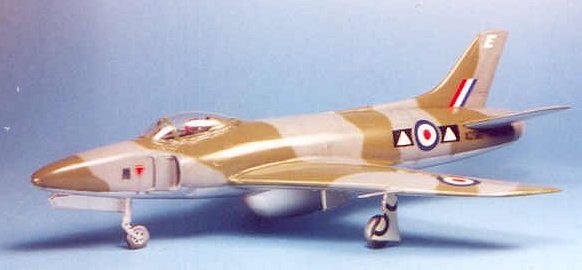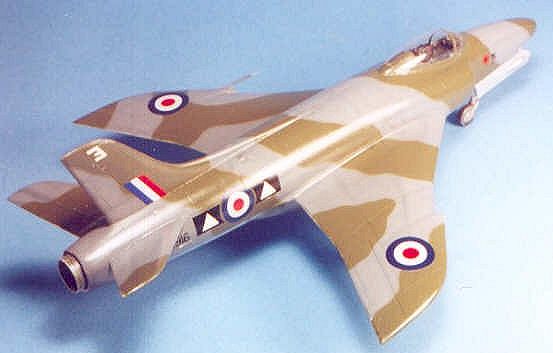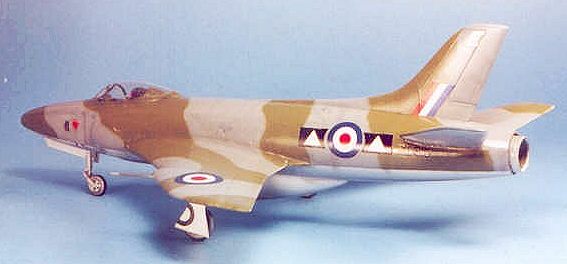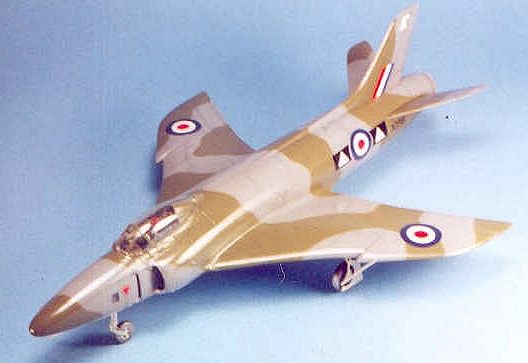
|
KIT: |
Falcon 1/48 Swift FR.5 |
|
KIT # |
|
|
PRICE: |
$22.95 |
|
DECALS: |
N/A |
|
REVIEWER: |
|
|
NOTES: |
Vacuformed plastic. |

|
HISTORY |
In the years immediately following the Second World War, the pace of aircraft development slowed in Britain. In part, this was due to the fact that no immediate enemy was perceived, which is a natural reason for governments to slow the pace of expenditures. On another level, though, Britain was literally worn out from the effort to win the Second World War; everyone seemed to slow their pace. Unfortunately, this would result in the British first-generation jets - the Meteor and the Vampire - having to soldier on past their time. The decision not to pursue supersonic flight following the death of Geoffrey deHavilland in the D.H.108 meant there was no likelihood of "jumping a generation" of development. By the time the British swept-wing fighters achieved initial service, the F-86 had been in service five years and had successfully fought a war.
Supermarine, the makers of the Spitfire - the leading British fighter of the war - seemed also to lose their step in the immediate post-war years. The Spiteful was not a success, and their first jet fighter design, the Attacker, was thoroughly pedestrian in performance and backward in design with its conventional tailwheel landing gear. Hawker's competing Sea Hawk was by far the superior design.
 With Hawker working on
the initial design of the swept-wing Hunter, Supermarine determined to enter the
swept-wing race with the Type 510, which was basically an Attacker with swept
wings. Given the developmental background, it is not surprising that the 510s
first flight on December 29, 1948, was the first flight of a British jet
aircraft with swept wings and tailplane. Since it was powered by the centrifugal
Rolls Royce Nene engine the fuselage of the Type 510 was larger than the
Hunter. When VV106 went through carrier trials, it became the first swept‑wing
jet anywhere to land and take off from a carrier. The 510 needed further
development to improve performance at high speeds and altitudes, and the flight
program demonstrated that greater stability was badly needed.
With Hawker working on
the initial design of the swept-wing Hunter, Supermarine determined to enter the
swept-wing race with the Type 510, which was basically an Attacker with swept
wings. Given the developmental background, it is not surprising that the 510s
first flight on December 29, 1948, was the first flight of a British jet
aircraft with swept wings and tailplane. Since it was powered by the centrifugal
Rolls Royce Nene engine the fuselage of the Type 510 was larger than the
Hunter. When VV106 went through carrier trials, it became the first swept‑wing
jet anywhere to land and take off from a carrier. The 510 needed further
development to improve performance at high speeds and altitudes, and the flight
program demonstrated that greater stability was badly needed.
The 510 was modified to the Type 528, which shortly after its first flight on March 27, 1950, was modified to a nosewheel arrangement with a longer, pointed nose, a kinked wing leading edge, and larger fuselage diameter to accommodate an afterburner; now known as the Type 535, it first flew on August 23, 1950. As an aside, both the Type 510 and the Type 535 can be seen in the very good (even if very inaccurate) movie, "Breaking the Sound Barrier."
At this point, Hawker had flown the prototype Hunter, and was entering the prolonged testing period to find the proper location of the ventral dive brake and the correct shape for the shell collectors. With the Hunter's progress delayed, Supermarine was awarded a produce 100 aircraft based on the Type 535, to be named Swift. Known to the company as the Type 541, power was changed from the Nene to the more powerful Rolls Royce Avon, which was also used in the Hunter. WJ960, the Swift prototype, first flew on August 1, 1951. The second, WJ965, did not fly until July, 1952, after which two forced landings caused a delay in the program.
The Swift F.1 first flew in March 1953. An armament increase from two 20mm cannon to four 30mm cannon resulted in the Swift F.2. Unfortunately, the extra room for the extra ammunition was created by extending the wings forward at the fuselage joint; flight test showed this caused a problem whereby the Swift could go into an abrupt pitch‑up attitude which resulted in the airplane going inverted in a matter of seconds. Extra ballast was added to the nose to correct this, which lowered performance. The ultimate cure was a variably-incidence horizontal stabilizer, which appeared in the F.4 that first flew in May 1953.
The F.4 was the Swift variant used to break the world absolute speed record on September 26, 1953; at 735 mph, the Swift, beat Neville Duke's record of 727 mph in a Hunter F.3 set three weeks earlier. Days later, the Douglas XF4D-1 Skyray established a record of 753 miles per hour, which would be broken within the year by the North American YF-100 Super Sabre.
 The Swift F.1 reached 56
Squadron of Fighter Command on February 13, 1954, the become the first
swept-wing fighter to enter RAF service. By August 1954, a number of accidents
resulted in the grounding of all Swifts. The restrictions were relaxed on
August 30 with the arrival of the Swift F.2; however two aircraft were lost in
pitch‑up accidents shortly thereafter and the Swifts were again grounded. In
March 1955, Fighter Command ordered the withdrawal of the Swift from service
when it was found that the F.4's afterburner could not be lit at high altitude,
which ended its usefulness as an interceptor.
The Swift F.1 reached 56
Squadron of Fighter Command on February 13, 1954, the become the first
swept-wing fighter to enter RAF service. By August 1954, a number of accidents
resulted in the grounding of all Swifts. The restrictions were relaxed on
August 30 with the arrival of the Swift F.2; however two aircraft were lost in
pitch‑up accidents shortly thereafter and the Swifts were again grounded. In
March 1955, Fighter Command ordered the withdrawal of the Swift from service
when it was found that the F.4's afterburner could not be lit at high altitude,
which ended its usefulness as an interceptor.
At this point, production then switched to the Type 549 F.R.5, a low‑level reconnaissance variant. The F.R.5, fitted with a lengthened nose housing cameras and armed with two 30mm cannon, was a useful aircraft; since it operated at medium to low level, the high altitude reheat problem did not matter. The F.R.5 joined 2 Squadron in Germany in March 1956. Pilots who flew the airplane discovered that at altitudes under 2,000 feet - the optimum operating environment for a tactical recon fighter - the airplane outperformed any other jet. In 1957 and 1959, 2 Squadron's Swifts won the NATO "Royal Flush" reconnaissance competition, beating the American RF‑84 Thunderflash. The punishing low‑level tac-recon role proved no problem for the strong airframe; no fatigue problems were ever encountered. The F.R.5s were eventually replaced in 1961 by the Hunter F.R.10.
Often regarded as a complete failure, the Swift was from the start hampered by the problem associated in changing the engine from the Nene to the Avon and the lack of time to develop the aircraft. The airplane had only ever been intended as a back‑up in case the Hunter failed.
|
THE KIT |
There are a number of interesting airplanes that are never going to see the light of day as injection-molded kits, and the Swift is one of them. Fortunately, Falcon Industries brought out a very good vacuform in 1989. This kit is a "classic" vacuform, without the various resin detail parts that one now finds in Dynavector vacuforms, though it does have white metal landing gear and an Aeroclub white metal Martin Baker Mk.2 ejection seat. The kit also comes with decals for an F.R.5 of 2 Squadron, and with markings for one of the later F.7s that were produced. There are additional parts that allow the modeler to make the F.7, which featured a longer nose and extended wingtips. Detail is of the raised-line variety.
|
CONSTRUCTION |
The first thing one has to do with a vacuform is pop the parts off the backing sheet. I have learned to trace around the parts with a pencil before cutting them loose; once off the backing sheet, the penciled line allows me to see when I have sanded the part down properly.
 Because the kit is an
older vacuform, this meant I had to scratchbuild additional detail for the
cockpit, which is only provided as a vacuformed tub. The instructions provide a
good drawing of the cockpit interior, and I was able to add in a throttle,
rudder pedals, and other small details; since the cockpit is painted black,
there isn't really a lot of detail to be seen even through the very clear Falcon
vacuformed canopy. I painted the Aeroclub white metal seat, and added seatbelts
made from lead foil taken from a wine bottle.
Because the kit is an
older vacuform, this meant I had to scratchbuild additional detail for the
cockpit, which is only provided as a vacuformed tub. The instructions provide a
good drawing of the cockpit interior, and I was able to add in a throttle,
rudder pedals, and other small details; since the cockpit is painted black,
there isn't really a lot of detail to be seen even through the very clear Falcon
vacuformed canopy. I painted the Aeroclub white metal seat, and added seatbelts
made from lead foil taken from a wine bottle.
When assembling the fuselage halves, I find it useful to glue in a thin strip of evergreen sheet, to give more of a surface for mating when gluing these parts together. I also made a bulkhead for the rear fuselage that I would later attach the afterburner to. Because the kit offers the opportunity to make either the F.R.5 or F.7, this means the nose is separate from the rest of the fuselage. I scratchbuilt the jet intake walls and blanked them off, then inserted the cockpit and finally glued the nose to the fuselage.
The wing is in three parts - a one piece lower wing and the left and right upper surfaces. I scratchbuilt gear wells on the lower surface after cutting open the wells, then glued the wing sub assembly together. I then glued on the belly "slipper tank."
Once the wing and fuselage were glued together, I puttied all the seams and set it aside to dry. I found myself doing quite a bit of sanding, re-puttying, more sanding, more re-puttying, but eventually the seams all disappeared and everything was smoothed off with Mr. Surfacer.
I re-scored the panel lines with a #11 X-acto blade, then attached the horizontal stabilizers and attached the canopy, which I had Futured. I also attached the landing gear in position and attached the gear doors.
|
PAINT & DECALS |
 Painting:
Painting:
First I gave the model an overall coat of light grey to insure I had indeed gotten all the seams. I had. I then pre-shaded the model by air-brushing flat black along all the panel lines.
The underside was painted the "silvery grey" used by RAF fighters in the 1950s - this was a mixture of Tamiya Flat Aluminum and Sky Grey. This was then masked off, and the upper camouflage was painted. I used Tamiya Dark Sea Grey and Gunze-Sanyo "Olive Drab 1" - a green-shade Olive Drab that approximates the color of "Dark Green" used in this period on RAF aircraft. I freehanded the camouflage pattern. Once everything was dry, the model received two coats of Future.
Decals:
The roundels and fin flash in the kit-supplied decals were out of register, so I obtained replacements from the decal dungeon. I used the kit decals for the serial numbers and squadron insignia. These decals were both old and flat-textured, so they came out a bit different color than the surrounding background once they set up. After painting everything gloss again, this difference was less apparent. (And yes, I did notice - after I took these pictures - that the aircraft ID letter, the "E" on the rudder, was applied backwards on the right side; this has since been corrected.)
|
CONCLUSIONS |
 I like the the early jets, because their designers
didn't yet know "what worked," which means they came up with some interesting
shapes. The Swift, with its crescent-shaped wing designed to delay the onset of
the supersonic drag rise, is one of those different-looking jets. It looks very
nice sitting between to the Academy Hunter and the vacuformed Hawker Sea Hawk.
Building a vacuform is for me a diverting challenge - a good kit like this can
create a fun project, with the result being a model one doesn't see every day.
I like the the early jets, because their designers
didn't yet know "what worked," which means they came up with some interesting
shapes. The Swift, with its crescent-shaped wing designed to delay the onset of
the supersonic drag rise, is one of those different-looking jets. It looks very
nice sitting between to the Academy Hunter and the vacuformed Hawker Sea Hawk.
Building a vacuform is for me a diverting challenge - a good kit like this can
create a fun project, with the result being a model one doesn't see every day.
July July 2002
If you would like your product reviewed fairly and quickly where it will be seen by well over 150,000 visitors a month, please contact me or see other details in the Note to Contributors.